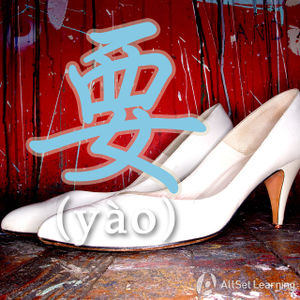Difference between revisions of "Expressing "either... or..." with "yaome""
| Line 1: | Line 1: | ||
{{Grammar Box}} | {{Grammar Box}} | ||
| − | You can give a series of alternatives by using 要么 (yàome). The structure is pretty versatile, as you can put a wide variety of things after each 要么: | + | You can give a series of alternatives by using 要么 (yàome). The structure is pretty versatile, as you can put a wide variety of things after each 要么:\r\n==Structure==\r\n<div class="jiegou">\r\n要么 + Option A + 要么 + Option B\r\n</div>\r\n==Examples==\r\nFirstly, you can use an [[adverb]] (extra information about the verb such as time, manner or place). Some examples:\r\n<div class="liju">\r\n* 你 <strong>要么</strong> <em>今天</em> 过来 ,<strong>要么</strong> <em>后天</em> 过来 。<span class="trans">You can either come back today or the day after tomorrow.</span> |
| − | + | * 咱们 <em>要么</em> 说 汉语,<em>要么</em> 就 别 说话。<span class="trans">We'll either speak Chinese or another language.</span>\r\n</div>\r\nSecondly, different objects can be given as options:\r\n<div class="liju">\r\n* 我们 <strong>要么</strong> 喝 <em>葡萄酒</em>,<strong>要么</strong> 喝 <em>啤酒</em>。<span class="trans">We either drink wine or we drink beer.</span>\r\n</div>\r\nDifferent subjects also work:\r\n<div class="liju">\r\n* <strong>要么</strong> <em>你</em> 去,<strong>要么</strong> <em>我</em> 去。<span class=" | |
| − | ==Structure== | + | trans">Either you go or I go.</span>\r\n</div>\r\n==See also== |
| − | |||
| − | <div class="jiegou"> | ||
| − | |||
| − | |||
| − | |||
| − | </div> | ||
| − | |||
| − | ==Examples== | ||
| − | |||
| − | |||
| − | |||
| − | <div class="liju"> | ||
| − | |||
| − | * 你 <strong>要么</strong> <em>今天</em> 过来 ,<strong>要么</strong> <em>后天</em> 过来 。<span class="trans">You can either come back today or the day after tomorrow.</span> | ||
| − | * 咱们 <em>要么</em> 说 汉语,<em>要么</em> 就 别 说话。<span class="trans">We'll either speak Chinese or another language.</span> | ||
| − | |||
| − | </div> | ||
| − | |||
| − | |||
| − | |||
| − | <div class="liju"> | ||
| − | |||
| − | * 我们 <strong>要么</strong> 喝 <em>葡萄酒</em>,<strong>要么</strong> 喝 <em>啤酒</em>。<span class="trans">We either drink wine or we drink beer.</span> | ||
| − | |||
| − | </div> | ||
| − | |||
| − | |||
| − | |||
| − | <div class="liju"> | ||
| − | |||
| − | * <strong>要么</strong> <em>你</em> 去,<strong>要么</strong> <em>我</em> 去。<span class=" | ||
| − | trans">Either you go or I go.</span> | ||
| − | |||
| − | </div> | ||
| − | |||
| − | ==See also== | ||
*[[Providing two options with double "huozhe"]] | *[[Providing two options with double "huozhe"]] | ||
| − | *[[Expressing the only two possibilities]] | + | *[[Expressing the only two possibilities]]\r\n== Sources and further reading ==\r\n=== Books ===\r\n* [[Integrated Chinese: Level 2, Part 1]] (pp. 158) [http://www.amazon.com/gp/product/0887276792/ref%3das_li_ss_tl?ie=UTF8&tag=allset-20&linkCode=as2&camp=217145&creative=399369&creativeASIN=0887276792 →buy] |
| − | + | * [[New Practical Chinese Reader 4 (新实用汉语课本4)]] (pp. 165) [http://www.amazon.com/gp/product/7561913192/ref%3das_li_ss_tl?ie=UTF8&tag=allset-20&linkCode=as2&camp=217145&creative=399369&creativeASIN=7561913192 →buy] \r\n | |
| − | == Sources and further reading == | ||
| − | |||
| − | === Books === | ||
| − | |||
| − | * [[Integrated Chinese: Level 2, Part 1]] (pp. 158) [http://www.amazon.com/gp/product/0887276792/ref%3das_li_ss_tl?ie=UTF8&tag=allset-20&linkCode=as2&camp=217145&creative=399369&creativeASIN=0887276792 →buy] | ||
| − | * [[New Practical Chinese Reader 4 (新实用汉语课本4)]] (pp. 165) [http://www.amazon.com/gp/product/7561913192/ref%3das_li_ss_tl?ie=UTF8&tag=allset-20&linkCode=as2&camp=217145&creative=399369&creativeASIN=7561913192 →buy] | ||
| − | |||
| − | |||
[[Category:B2 grammar points]] | [[Category:B2 grammar points]] | ||
{{Basic Grammar|要么|B2|要么……,要么……|你 <em>要么</em> 今天 过来 , <em>要么</em> 后天 过来 。|grammar point|ASG30A60}} | {{Basic Grammar|要么|B2|要么……,要么……|你 <em>要么</em> 今天 过来 , <em>要么</em> 后天 过来 。|grammar point|ASG30A60}} | ||
Revision as of 09:15, 26 November 2013
-
Level
-
Similar to
-
Used for
-
Keywords
You can give a series of alternatives by using 要么 (yàome). The structure is pretty versatile, as you can put a wide variety of things after each 要么:\r\n==Structure==\r\n
\r\n==Examples==\r\nFirstly, you can use an adverb (extra information about the verb such as time, manner or place). Some examples:\r\n
- 咱们 要么 说 汉语,要么 就 别 说话。We'll either speak Chinese or another language.\r\n
\r\nSecondly, different objects can be given as options:\r\n
\r\nDifferent subjects also work:\r\n
\r\n==See also==



